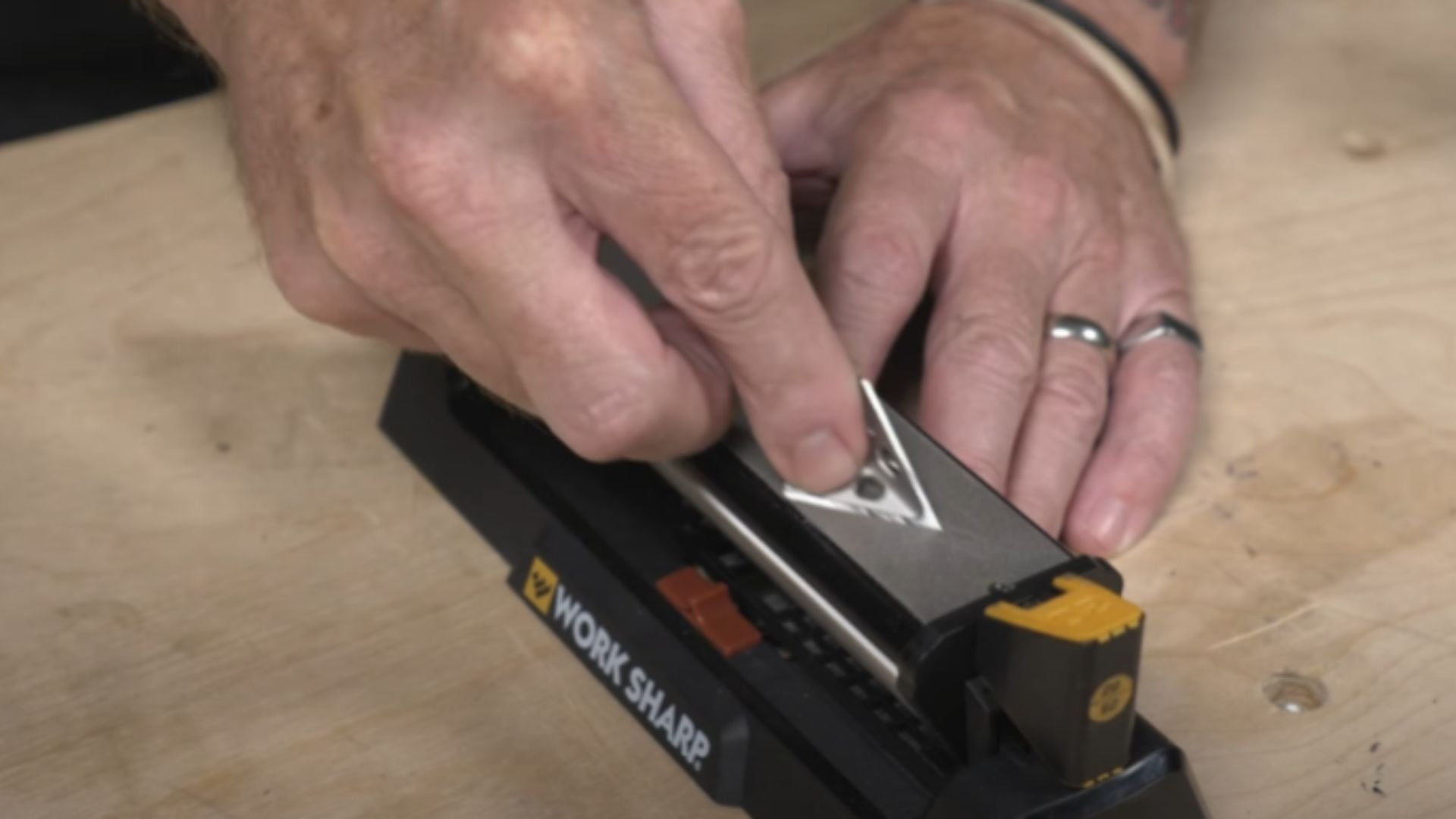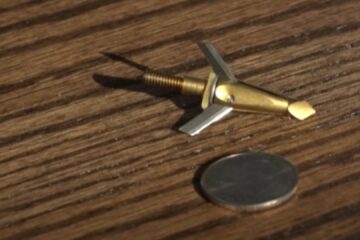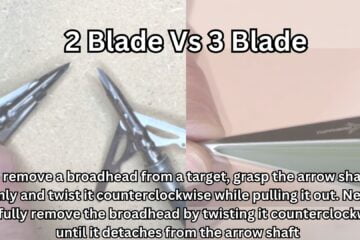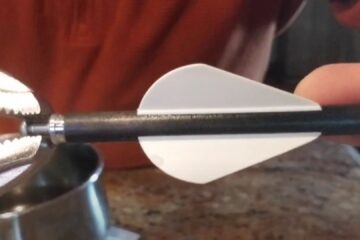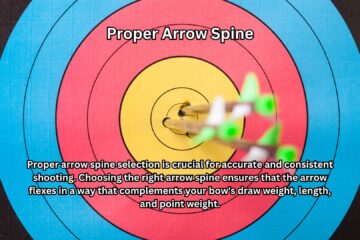To sharpen a broadhead, you will need a sharpening stone and a steady hand. Are you an archery enthusiast looking to improve your accuracy in the field?
One way to achieve this is by ensuring that your broadheads are properly sharpened. A sharp broadhead can make all the difference when it comes to hitting your target with precision. In this guide, we will walk you through the process of sharpening a broadhead, step by step.
From gathering the necessary tools to honing the edges of your blades, you will be equipped with the knowledge and skills to maintain sharp and effective broadheads. So, grab your sharpening stone and let’s get started on sharpening those broadheads!
Understanding Broadheads
Broadheads are an essential component of archery, and understanding how to sharpen them is crucial. Keep your broadheads in top shape by following simple steps to maintain their sharpness for accurate and effective shots.
When it comes to archery, understanding the different types of broadheads is crucial for success. Broadheads are the arrow tips specifically designed for hunting, and a sharp broadhead is essential for a clean and humane kill. In this section, we will explore the types of broadheads, the anatomy of a broadhead, and the importance of keeping them sharp.
Importance Of Sharp Broadheads:
Having sharp broadheads is crucial for successful hunting for several reasons:
- Enhanced Accuracy: Sharp broadheads deliver accurate shots, as they pass through the target cleanly without veering off course.
- Maximum Penetration: A dull broadhead may fail to penetrate the target effectively, leading to wounded animals and tracking difficulties.
- Better Blood Trails: Sharp broadheads create larger and more prominent blood trails, making it easier to track and recover your game.
- Quick and Humane Kills: A sharp broadhead ensures a swift and humane kill by causing extensive damage to vital organs.
- Prevent Deflection: Dull broadheads are more likely to deflect upon contact with bone or other obstacles, potentially causing missed shots.
In the next section, we will delve into the process of sharpening broadheads to ensure optimal performance in the field.
Materials And Tools For Sharpening Broadheads
Discover the essential materials and tools needed for sharpening broadheads effortlessly. Learn how to sharpen a broadhead effectively with these expert-recommended materials and tools, ensuring optimal hunting performance.
Selecting The Right Materials:
- Broadhead sharpening stone: Choose a stone specifically designed for sharpening broadheads, as these stones have a durable and coarse surface that helps to remove material efficiently.
- Lubricant: It is essential to use a lubricant while sharpening your broadheads to prevent the stone from clogging and enhance the sharpening process. Common lubricants include honing oil, water, or saliva.
- Safety gloves: Protect your hands by wearing a pair of safety gloves during the sharpening process. They provide a better grip and minimize the risk of accidentally cutting yourself.
- Safety glasses: Safeguard your eyes from any debris or metal fragments by wearing safety glasses. These glasses shield your eyes and ensure a safer sharpening experience.
- Flat file: A flat file is useful for removing any burrs or imperfections on the broadhead’s cutting edges. It helps create a smooth and even surface for sharpening.
- Soft cloth: Keep a soft cloth handy to wipe off any excess debris or lubricant from the broadheads after sharpening. This will ensure clean and ready-to-use broadheads.
Essential Tools For Sharpening Broadheads:
- Broadhead wrench: A broadhead wrench is a specialized tool that helps to safely and securely hold the broadhead while you sharpen it. It prevents any accidental injuries and ensures stability during the sharpening process.
- Arrow shaft: Using an arrow shaft is an effective method to stabilize the broadhead while sharpening it. Insert the broadhead into the arrow shaft, which provides support and allows for easier sharpening.
- Sharpening jig: A sharpening jig is a valuable tool that assists in maintaining the correct angle while sharpening your broadheads. It is especially helpful for beginners who may struggle to achieve consistent results without a jig.
- Honing guide: If you prefer to use a sharpening stone, a honing guide can help you maintain a consistent angle throughout the sharpening process. It clamps onto the broadhead and ensures an accurate and uniform edge.
- Marker or pen: Marking the edges of your broadheads with a marker or pen allows you to track your progress while sharpening. It helps identify areas that require further attention and ensures even sharpening on both sides.
Safety Precautions While Sharpening:
- Find a well-ventilated area: Ensure you have good ventilation while sharpening your broadheads to avoid inhaling any dust or particles. Working outdoors or near an open window can help maintain a safe environment.
- Use a stable work surface: Set up your sharpening station on a stable and level surface to prevent any accidents or slips during the process. A sturdy workbench or table will provide a secure platform.
- Maintain a firm grip: When holding your broadhead or using tools, always maintain a firm grip to avoid unintended slips or injuries. Take your time and concentrate on your movements.
- Sharpen away from your body: Always sharpen the broadhead away from your body, keeping your hands and fingers clear of the sharpening area. This reduces the risk of accidental cuts or injuries.
- Follow manufacturer guidelines: Read and follow the manufacturer’s instructions or guidelines specific to your broadheads. Different broadhead designs may require specific techniques or precautions during sharpening.
Remember, using the right materials and tools, along with practicing safety precautions, will ensure successful and safe broadhead sharpening.
Step-By-Step Guide To Sharpening Broadheads
Looking for a step-by-step guide to sharpening broadheads? This comprehensive guide will provide you with easy-to-follow instructions on how to sharpen your broadheads effectively.
You’ve made the wise decision to sharpen your broadheads, ensuring they are razor-sharp for your next hunting adventure. Properly sharpened broadheads are essential for achieving accurate and effective shots. In this step-by-step guide, we’ll walk you through the process of sharpening broadheads, covering topics such as preparing the broadhead, sharpening techniques for different types of broadheads, the proper angle and pressure for sharpening, and finally, testing the sharpness of the broadhead.
Preparing The Broadhead For Sharpening
Before you start sharpening your broadheads, it’s important to properly prepare them. Follow these steps to ensure your broadheads are ready for sharpening:
- Gather your materials: You’ll need a sharpening stone or file, safety gloves, and a lubricant such as water or honing oil.
- Remove the broadhead from the arrow shaft: Carefully detach the broadhead from the arrow shaft to have easier access for sharpening.
- Clean the broadhead: Use a soft cloth or brush to remove any dirt, debris, or rust from the broadhead. A clean surface will ensure effective sharpening.
- Protect yourself: Put on safety gloves to protect your hands while sharpening the broadhead. Safety should always come first.
Sharpening Techniques For Different Types Of Broadheads
Not all broadheads are created equal, and different types require specific sharpening techniques. Here’s how to sharpen different types of broadheads:
- Fixed-blade broadheads: Place the broadhead flat against the sharpening stone or file. Maintain a consistent angle and lightly stroke the blade along the stone or file in a sweeping motion. Repeat this process on both sides of the blade until the cutting edge is sharp.
- Mechanical broadheads: These broadheads have retractable blades, so sharpening them requires extra caution. Follow the manufacturer’s instructions to disassemble the broadhead and sharpen the individual blades. Take care to maintain the original angle of the blades while sharpening.
- Replaceable-blade broadheads: These broadheads have removable blades, making sharpening a breeze. Simply swap out dull blades with sharp replacements as needed. Note that some replaceable-blade broadheads can also be sharpened individually by placing them flat against a sharpening stone or file.
Proper Angle And Pressure For Sharpening
When sharpening broadheads, it’s crucial to maintain the proper angle and pressure. Follow these guidelines for optimal results:
- Angle: Most broadheads have a bevel angle ranging from 20 to 30 degrees. Aim for a consistent angle throughout the sharpening process to ensure an even cutting edge.
- Pressure: Apply gentle pressure when stroking the blade along the sharpening stone or file. Let the stone or file do the work for you, and avoid using excessive force that could damage the broadhead.
Testing The Sharpness Of The Broadhead
Once you’ve sharpened your broadhead, it’s essential to test its sharpness before hitting the field. Use the following method to ensure your broadhead is ready for action:
- Visual examination: Inspect the cutting edge of the broadhead under good lighting. Look for a clean, uniform edge without any visible dullness or nicks. A sharp edge should reflect light evenly.
- Paper test: Hold a sheet of paper with one hand and attempt to slice through it with the broadhead. A sharp broadhead should effortlessly cut through the paper with a clean, precise incision.
Congratulations! You’ve successfully learned how to sharpen your broadheads using our step-by-step guide. Remember to always prioritize safety, follow manufacturer guidelines, and test the sharpened broadhead before use. Sharpened broadheads will undoubtedly enhance your hunting experience, improving your accuracy and increasing your chances of success.
Happy sharpening and happy hunting!
Maintenance And Care For Sharp Broadheads
Easily maintain and care for your sharp broadheads with these simple steps. Learn how to sharpen your broadheads to ensure optimal performance and accuracy.
Imagine you’re all set for your next hunting expedition – your broadheads are sharp and ready to go. But are you taking proper care of them? Maintaining and caring for sharp broadheads is crucial to ensure optimal performance and longevity.
In this section, we will explore some essential tips to help you keep your broadheads in top condition.
Storing Sharp Broadheads
Proper storage is key to maintaining the sharpness of your broadheads. Here’s what you need to do:
- Before storing, make sure your broadheads are clean and dry.
- Use a dedicated broadhead case or box to prevent any damage during transportation and storage.
- Position the broadheads in the case or box securely to avoid any contact that could dull their edges.
- Store the broadheads in a cool, dry place, away from extreme temperatures and humidity.
Checking For Damages And Wear
Regularly inspecting your broadheads for damages and wear is crucial. Here are some steps to follow:
- Inspect the blades for any signs of damage or bending. If you notice any issues, replace the damaged blades.
- Check the ferrules for any cracks or deformities. Damaged ferrules should be replaced promptly to maintain optimal performance.
- Examine the threads of mechanical broadheads and ensure they are functioning properly.
- Look for any signs of rust or corrosion. If present, clean the affected areas and consider applying a protective coating.
Tips For Maintaining Sharpness
Keeping your broadheads sharp is essential for accurate and effective hunting. Follow these tips to maintain their sharpness:
- After each use, clean the broadheads thoroughly to remove any blood, dirt, or debris. Use warm soapy water and a soft brush.
- Dry the broadheads completely to prevent rusting.
- Consider using a sharpening stone or a broadhead-specific sharpener to touch up the edges between hunting trips.
- Store broadheads individually to prevent any contact that could dull their edges.
- Avoid repeatedly shooting broadheads into hard surfaces such as rocks or tree trunks, as this can cause them to become dull quickly.
By following these maintenance and care tips, you can ensure that your broadheads stay sharp, perform optimally, and provide consistent results for your hunting adventures. Take the time to inspect and store your broadheads properly, and you’ll reap the benefits of accurate and efficient shooting.
Troubleshooting Common Issues With Broadhead Sharpening
Learn how to troubleshoot common issues with broadhead sharpening techniques in this informative guide. Discover effective tips and tricks to help you sharpen your broadheads for better accuracy and performance.
Whether you’re an experienced hunter or new to archery, sharpening your broadheads is a crucial skill to ensure accurate and effective shots. However, there are several common issues that can arise during the sharpening process. In this section, we will discuss the mistakes to avoid, how to fix dull or damaged broadheads, and how to deal with alignment issues.
Common Mistakes To Avoid While Sharpening
When sharpening your broadheads, it’s important to be mindful of the following mistakes to achieve optimal results:
- Inconsistent angle: One of the most common mistakes is sharpening the broadhead at an inconsistent angle. To avoid this, use a sharpening guide or jig to maintain a consistent angle throughout the process.
- Over-sharpening: Sharpening beyond the original edge of the broadhead can weaken it and lead to breakage upon impact. Be cautious and avoid removing excessive material while sharpening.
- Neglecting blade symmetry: Failing to ensure the blades are symmetrical can result in imbalanced flight and reduced accuracy. Take your time to carefully align and sharpen each blade equally.
- Poor blade alignment: Blades that are not properly aligned can cause the broadhead to veer off target. Ensure that all blades are aligned parallel to the shaft of the arrow to achieve optimal flight and accuracy.
- Inadequate deburring: A common oversight is neglecting to remove burrs from the edges of the broadhead after sharpening. Use a fine-grit sharpening stone or sandpaper to smooth out any rough edges.
Fixing Dull Or Damaged Broadheads
Over time, broadheads can become dull or damaged due to use. Here are some steps to restore their sharpness and functionality:
- Inspection: Before sharpening, carefully inspect your broadheads for any signs of damage or chips. If the blades are severely damaged or bent, it may be necessary to replace them.
- Blade alignment: Ensure that all blades are properly aligned and straight. If any blades are misaligned, gently realign them using a pair of pliers.
- Sharpening: Use a sharpening stone or diamond file to sharpen the blades. Take care to maintain a consistent angle and remove as little material as possible while achieving a sharp edge. Start at the base of the blade and work towards the tip in smooth, even strokes.
- Deburring: After sharpening, lightly deburr the edges of the broadhead to remove any burrs or rough spots. This can be done using a fine-grit sharpening stone or sandpaper.
- If needed, repeat the sharpening and deburring process until the broadheads are adequately sharp.
Dealing With Alignment Issues
Improper alignment can cause broadheads to fly off course, resulting in inaccurate shots. Here’s how to address alignment issues:
- Blade replacement: If the blades are severely misaligned and cannot be corrected, it may be necessary to replace them. Ensure that the replacement blades are properly aligned before attaching them to the broadhead.
- Blade adjustment: Using a pair of pliers, carefully adjust misaligned blades by bending them back into place. Take caution not to exert excessive force or damage the blades in the process.
- Test shots: After making adjustments, test the broadheads by taking a few practice shots. Assess the flight pattern and accuracy to determine if further adjustments are needed.
By avoiding common mistakes, regularly inspecting and sharpening your broadheads, and addressing any alignment issues, you can ensure that your shots are accurate and effective. Remember to always prioritize safety and take your time to perfect your broadhead sharpening skills.
Pro Tips For Maximizing Broadhead Sharpness
Learn the essential tips for maximizing the sharpness of your broadheads. Discover effective techniques for sharpening a broadhead to achieve optimal performance and accuracy.
Having sharp broadheads is essential for successful hunting and consistent accuracy. Dull broadheads can result in poor penetration and ineffective kills. To ensure your broadheads are as sharp as possible, follow these pro tips:
Selecting The Right Broadhead For Your Needs:
- Consider the type of game you will be hunting: Different broadheads are designed for various game sizes and hunting situations. Choose a broadhead that is suitable for your specific needs.
- Select the appropriate cutting diameter: Broadheads come in different cutting diameters, such as 2-blade and 3-blade options. The cutting diameter directly affects the size of the wound channel and blood loss, so choose accordingly.
- Evaluate material and construction: Broadheads can be made from different materials such as steel or aluminum. Consider the durability, strength, and overall quality of the broadhead when making your selection.
Proper Arrow Maintenance:
- Inspect arrows regularly: Before each use, carefully inspect your arrows for any cracks, fractures, or other signs of damage. Replace any damaged arrows to ensure your safety and accuracy.
- Clean and lubricate your arrows: After each use, clean your arrows with a mild detergent and water solution to remove any dirt or debris. Dry them thoroughly and apply a light coat of arrow lubricant to protect against rust and enhance performance.
- Store arrows properly: When not in use, store your arrows in a cool and dry place, preferably in an arrow case or a quiver that provides adequate protection. This will help prevent damage and maintain the arrow’s straightness.
Sharpening Frequency And Schedule:
- Assess sharpness regularly: Regularly check the sharpness of your broadheads using a sharpness test tool or carefully running your finger along the blade’s edge. Dull blades will not penetrate effectively, so it’s crucial to stay on top of their sharpness.
- Sharpen before each hunt: It’s recommended to sharpen your broadheads before every hunting trip, even if they appear to be sharp. This ensures maximum cutting efficiency and increases the chances of a successful kill.
- Invest in a quality broadhead sharpener: A dedicated broadhead sharpener is the best tool for sharpening your broadheads accurately. Make sure to follow the manufacturer’s instructions and take your time to achieve a razor-sharp edge.
By following these pro tips, you can maximize the sharpness of your broadheads, increasing your chances of a clean and humane kill. Remember, sharp broadheads are paramount for effective hunting, so prioritize their maintenance and sharpening to achieve optimal results.
Happy hunting!
Frequently Asked Questions On How To Sharpen A Broadhead
What Do You Use To Sharpen Broadheads?
To sharpen broadheads, you can use a sharpening stone or a broadhead file.
Can You Use A Knife Sharpener To Sharpen Broadheads?
Yes, a knife sharpener can be used to sharpen broadheads effectively.
Do Broadheads Need To Be Sharpened?
Broadheads do need to be sharpened periodically to maintain their effectiveness in hunting.
What Is The Easiest Broadhead To Sharpen?
The easiest broadhead to sharpen is a fixed-blade broadhead due to its simple design.
Conclusion
Sharpening your broadhead is a crucial step in ensuring its optimum performance and accuracy. By following the steps mentioned in this blog post, you can easily maintain and sharpen your broadhead at home. Regular maintenance not only prolongs the life of your broadhead but also improves its effectiveness in making clean and ethical kills.
Remember to use a sharpening stone or specialized tools specifically designed for broadheads, while being mindful of keeping a consistent angle. Taking the time to sharpen your broadhead will pay off in the field, as it will increase your chances of a successful hunt.
So, don’t overlook this essential step and make sure to keep your broadhead’s razor sharp for your next hunting adventure. Happy hunting!

